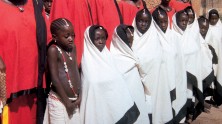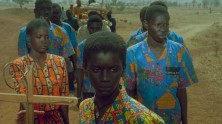
Black Girl
(La Noire de …)
With Mbissine Thérèse Diop, Anne-Marie Jelinek, Robert Fontaine.
Senegal/France, 1966, DCP, black & white, 59 min.
French with English subtitles.
DCP source: Janus Films
The first African film to win the Prix Jean Vigo, Ousmane Sembène’s La Noire de… is considered the first sub-Saharan African feature film to garner international recognition. An adaptation of his short story “The Promised Land,” the film denounces the neocolonial exploitation that Sembène deemed the "new black slave trade.” Allured by the gifts of a white French couple (Anne-Marie Jelinek and Robert Fontaine) and dreams of seeing France, Diouana (Mbissine Thérèse Diop) leaves Dakar to be their housemaid in Antibes. Immediately upon her arrival, she is subjected to grueling work and humiliating objectification. In decentering the film’s white characters, Sembène foregrounds the African worker who cooks, cleans and raises their children. He presents Diouana’s alienation with abrupt cuts—from wide to close-ups—and cutting irony: the France outside her window is actually Senegal, where the film was shot. She never opens her mouth and is only heard in French voiceover, dubbed in the language she cannot read. It is worth noting that upon its release, La Noire de…—today a seminal masterpiece of postcolonial cinema—received attention but not acclaim; in his review, Roger Ebert described the film as suffering from a "primitive naturalism."
PRECEDED BY
-
Niaye
Directed by Ousamane Sembène.
With Serigne Sow, Astou N’Diaye, Mame Dia.
Senegal/France , 1964, 35mm, black & white, 35 min.
French and Wolof with English subtitles.
Print source: Cinémathèque Française
For his second short film, Ousmane Sembène turned to his novella White Genesis. The tale is told by an observant griot, whose words function as a record of the immorality he has witnessed. When the chief of a village is revealed to have impregnated his thirteen-year-old daughter, the villagers’ concern is not the safety of the girl but that this incestuous act might become known to the French colonial authorities. The burden of shame falls on the chief’s wife and his son, a former soldier plagued with hallucinations of war. Niaye is an early example of Sembène’s indictment of African leaders, in this case a wicked chief backed by obsequious elders whose morals have been clouded by a desire to curry favor. Despite its short length, Niaye’s density—concentrated within and around a single village, stripped of expositional excess yet intricately structured—precedes Sembène’s later historical epics like Emitaï and Ceddo.














